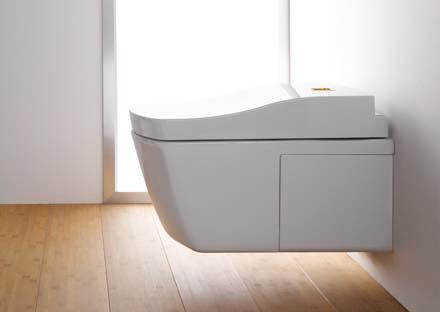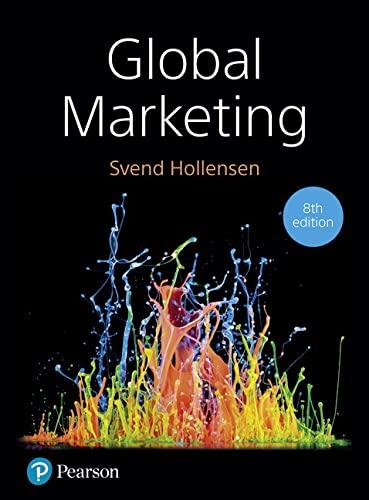An average person visits the toilet 2,500 times per year, about 68 times per day. People spend
Question:
An average person visits the toilet 2,500 times per year, about 6–8 times per day. People spend at least three years of their lives using the toilet, and women take three times as long to use the toilet as men (www.worldtoilet.org).
Founded in 1917, Japanese toilet maker TOTO (www.toto.co.jp) is the largest toilet manufacturer in the world, producing more than 14 million toilets annually. TOTO’s net sales in the financial year 2018 were US$5.6 billion; with a net profit of US$150 million.
Their total number of employees at the end of March 2019 was 28,000.

Over the years, TOTO has made a sales success in Japan. Japanese Government statistics show that the ‘innovative toilet seat’ that features an integrated bidet (represented by TOTO’s Washlet-
brand) are now installed in 70 per cent of Japanese homes compared to just 14 per cent in 1992. TOTO, which employs around 1,800 engineers, dominates this ‘innovative toilet seat’ market with a 55 per cent share. Its closest rival, Japan’s Lixil, trails at 25 per cent. Numbers for Japan’s overall toilet market in ‘water closets’ are like this: TOTO’s market share is 60 per cent while Lixil is about 30 per cent. TOTO’s market share is only very small outside Japan, with 15 per cent of TOTO’s total net sales coming from overseas in 2012. Lixil has a 25 per cent of its turnover outside Japan, after having aquired the US American Standard toilet brand (2013) and the German Grohe toilet brand (2014). The Chinese market is now the Toto number one target (55 per cent of overseas sales), and the US is the second
(25 per cent of overseas sales), but still the US is a key target for TOTO.
US market for toilets The US is one of the largest and most competitive markets in the world: in 2018, 13 million toilets (of which three-quarters were imports) were sold in the US market. TOTO’s sales to the US in 2018 were approximately US$200 million. In 1989, TOTO began to make inroads into the US market with the establishment of TOKI KiKi USA, Inc., but in 2018 its overall market share of the US toilet market was still only very small – approximately 8 per cent.
Americans are said to move residences once every seven or eight years, creating a used-home market larger than that in Japan. As a consequence, remodelling is effectively the same level as (or better than) that of new homes. Compared with Japan, the US has stricter water conservation regulations for toilets and spurred by these regulations, industry specialists expect to see demand for replacement toilets in the future.
New housing starts are over 1.6 million annually, thanks in part to low interest rates in the US new housing market. Even when you consider the 1.1 million new housing starts in Japan, the US housing market is substantially larger in scale, and therefore has more potential. TOTO is targeting high value-
added markets in the US through the kitchen/
bath shop and waterworks channels, and bypassing the home improvement centre channel. Through the kitchen/bath shop and waterworks channels TOTO provides customers with services, including consulting and installation for its products. In this way TOTO is hoping to capture market shares in the high-end of the US toilet market.
TOTO penetrates the US market but is facing cultural barriers
TOTO made toilet history in 1980 when, improving on a US model that combined the bidet and the toilet seat, it produced the ‘Washlet’, bringing warm water to the user’s nether regions. TOTO did what the American toilet makers were reluctant to try – it brought electronics into the water closet. Top-ofthe-
line Washlets now came with wall-mounted control panels as complex as those of stereo systems.
Their manifold buttons allow adjustment of the nozzle position, water pressure and type of spray, plus blow-drying, air purification and seat warming for those cold winter mornings. Water and seat temperatures are adjustable. The controls can also be set so the lid rises as the user approaches the Washlet. Globally, more than 50 million Washlets have been sold (mainly in Japan) since their introduction in 1980. The US, however, is a country without a history with the bidet. Bidets – usually stand-alone fixtures used in conjunction with toilets – originated in France and have been in use throughout the southern part of Europe since the 1700s. Ironically, almost three decades ago TOTO began importing hospital-grade bidets from the US to sell to Japan’s ageing population. It soon discovered there was a larger market for the fixtures and adapted the traditional bidet into a toilet seat attachment, which fits onto existing toilet bowls.
While US consumers are just waking up to Washlets, the Japanese are going even more upmarket.
TOTO’s new Neorest model, Washlet integrated toilet (introduced in 2003) gets rid of the inner rim of the bowl, like most of TOTO’s other toilet models around the world, and brings in ‘the tornado flush’.
The Neorest (priced at US$5,500) has all the features of TOTO’s Washlet, including a heated seat for cold nights, built-in back-and-front bidet with oscillating or pulsating spray massage and a warm-air dryer, all with temperature controls on a wall-mounted remote.
Add to these features the smart toilet’s built-in air purifier and motion sensors that detect your approach and automatically raise the lid. Males can lift the seat with the touch of a button and in doing so instruct the unit to flush with less water. Complete your business and the toilet automatically shuts the lid (while putting the seat down!) and flushes.
Questions
1. What cultural barriers would the Japanese managers from Toto meet when negotiating with American managers from building societies about new contracts for toilets in US luxury apartments?
2. Some analysts argue that tackling cultural toilet norms and barriers is not worth the effort and that Toto would be better off pulling its Washlets and Neorests out of the US and Europe altogether and concentrating on more receptive Asian markets like China, and of course Japan. Do you agree?
Why? Why not?
Step by Step Answer:






